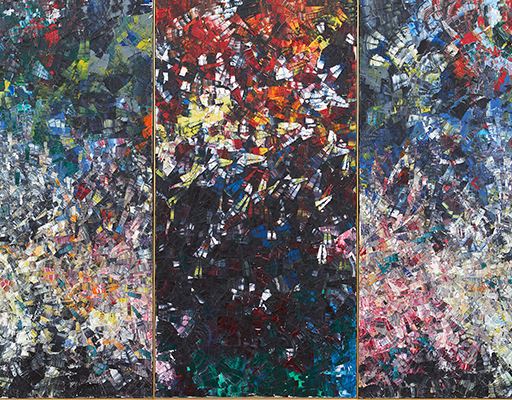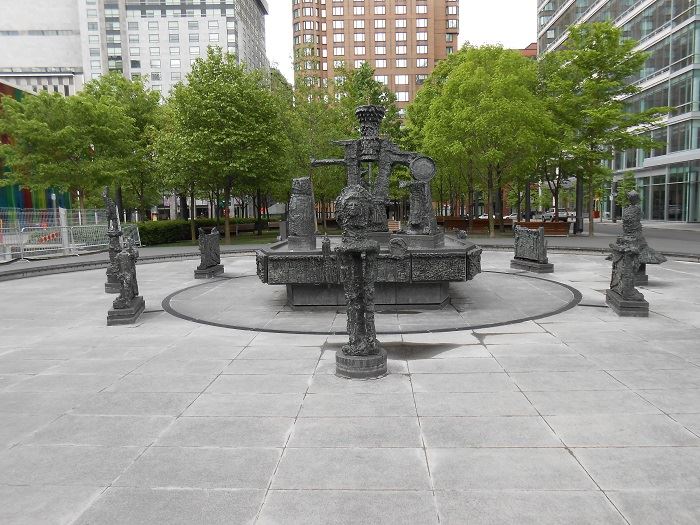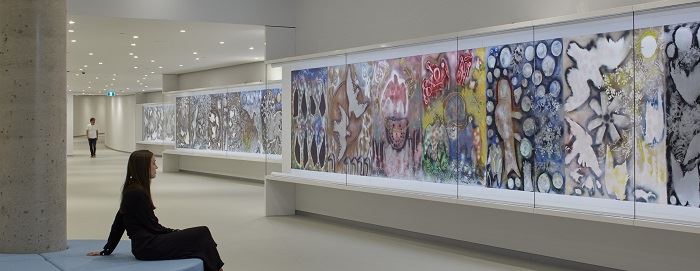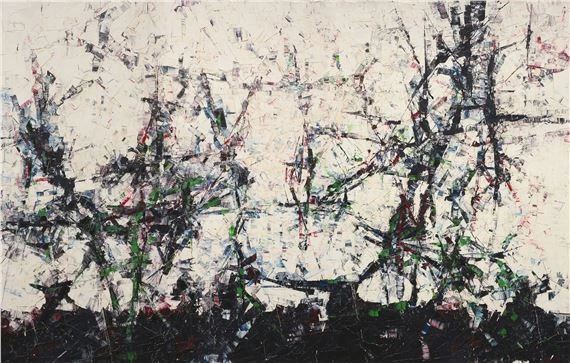Revisiting the legacy of Jean Paul Riopelle, whose art of refusal shaped modern Quebec and reverberates on the centenary of his birth
Adam Szymanski / MutualArt
In 1948, when Jean Paul Riopelle signed the manifesto Le réfus global (Total Refusal), it caused a major scandal in Quebec which even lost his mentor Paul-Émile Borduas his position at the École du Meuble de Montréal. In hindsight, it stands as a landmark document which provoked the social changes that have led to present-day Quebec. October 7, 2023, marks the centenary of Riopelle’s birth, and this grand occasion is being celebrated by major art and cultural institutions across Canada and abroad.
Jean Paul Riopelle, La Joute (1969-1970) in Place Jean Paul Riopelle in Montreal, bronze sculpture. Photo: Jean Gagnon
Jean Paul Riopelle: A Life of Refusal
Jean Paul Riopelle was born in Montreal in 1923 and in the 1940s he studied under Borduas, the leader of a group of dissident abstract artists known as the Automatistes. Riopelle, along with other Automatistes, was a signatory of Le réfus global. The combative manifesto called for a separation of Church and State, an end to clericalism, and ultimately a “future in which man is freed from useless chains, to realize a plenitude of individual gifts, in necessary unpredictability, spontaneity and resplendent anarchy.” These ideas guided Riopelle’s rejection of figurative forms, embrace of surrealist principles, and turn to heavy abstraction in the mid-1940s.
Discouraged by the provincialism of Quebec, Riopelle left for Paris in 1947. He became known for a signature abstract expressionist style that resulted from abandoning the paintbrush altogether. Through the direct use of the palette knife and trowel, Riopelle effectively sculpted with copious amounts of paint on large canvases to create a highly kinetic effect. His first solo exhibition took place in 1949 at the surrealist-oriented Galerie La Dragonne, and his work was included in the 1953 Guggenheim exhibition, Younger European Artists. Over the course of his lifetime, Riopelle created over six thousand works, mainly paintings and sculptures.
Despite moving in European circles throughout much of his life, Riopelle represented Canada at the Venice Biennale of 1954 and 1962, and he always maintained strong links to Quebec. For the Montreal Olympics of 1976, Riopelle created a beloved public sculpture fountain and homage to sport entitled La joute (The Joust). Later in his career, Riopelle opened a studio in Estérel before passing away on a remote island in the St. Lawrence River in 2002. He ultimately received the highest forms of recognition in his home country, including the National Order of Quebec and the Order of Canada, and a public square in Montreal proudly bears his name to this day.
Jean Paul Riopelle, Hommage aux Nymphéas – Pavane (1954), Oil on canvas. Photo: National Gallery of Canada, Jean Paul Riopelle Estate / SOCAN
Centenary Celebrations
A plethora of noteworthy art events have been scheduled to commemorate the Riopelle centenary. The most significant is undoubtedly the National Gallery of Canada’s retrospective exhibition entitled Riopelle: Crossroads in Time which opens on October 27, 2023. The half-year-long exhibition is guest curated by Sylvie Lacerte and combines over 130 works drawn from the NGC’s permanent collection and works on loan from public and private collections. Riopelle’s seminal 1954 triptych Hommage aux Nymphéas – Pavane (Tribute to the Water Lilies – Pavane) will be among the works on display. It will be the second time that Riopelle has earned a major exhibition at the National Gallery of Canada, with him having been bestowed the honor at the age of only 40 years old in 1963.
The retrospective will cap off a year that has already seen Riopelle garner significant attention. One of his most important later works, a melancholic narrative sequence of 30 paintings over 40 metres in length entitled L’Hommage à Rosa Luxemburg (Tribute to Rosa Luxemburg), represented Canada at the G20 Digital Museum exhibition in New Delhi. The artwork was displayed in a digital format, while the original hangs in the Musée national des beaux-arts du Québec.
The MNBAQ was the first institution to acquire a Riopelle in 1956, and to celebrate his centenary the museum is constructing an ambitious new pavilion called the Espace Riopelle, designed particularly with Tribute to Rosa Luxemburg in mind. Once construction is complete in 2025-2026, the pavilion will house the largest public collection of Riopelle works in the world.
Jean Paul Riopelle, L’Hommage à Rosa Luxemburg (Tribute to Rosa Luxemburg), 1992, acrylic and spray paint on canvas. Photo: Jean Paul Riopelle Estate/ SOCAN, Bruce Damonte
Tribute to Rosa Luxemburg’s realm of influence now extends beyond art and architecture, and into the realm of theatre as well. Touring Montreal, Ottawa, and Quebec City this year is a new play Robert Lepage entitled Le projet Riopelle (The Riopelle Project). It is staged in 30 tableaux as an homage to the 30 paintings in Tribute to Rosa Luxemburg, and reconstructs fragments of Riopelle’s life through people with whom he shared important relationships, including the American artist Joan Mitchell. Although none of Riopelle’s actual canvases appear on stage for the obvious logistical reasons, the play includes high-quality digital projections of Riopelle’s paintings and introduce audience members to a range of his works, thanks to the collaboration of The Riopelle Foundation with Lepage’s production company Ex Machina. The Riopelle Project has received positive reviews from critics and the Ottawa show dates for December have already sold out.
Other national events to commemorate Riopelle’s centenary include a commemorative $2 coin to be issued by the Royal Canadian Mint, a $1.3 million Canadian Heritage grant, and a 75-minute Riopelle Symphonique performed by Montreal symphony orchestra. On the international level, the Fondation Maeght in Saint-Paul de Vence, France, is presenting over 180 works as part of the exhibition Jean Paul Riopelle - Essence of studios which runs until November 12. This summer’s program at Fondation Maeght even included a dance performance choregraphed by Noé Soulier with sets that were imagined by Riopelle in 1967 for Merce Cunningham.
Deep Market Interest
The significance of the centenary has not been lost on the market for Riopelle’s works. Earlier this year, at Heffel’s Spring Auction Sale, two moderately sized Riopelles from the 1950s surpassed their high estimates and sold for over $475,000. At Christie’s Hong Kong on May 28, Riopelle’s 1954 painting Saint-Anthon achieved a sale price of $3,137,449, and a week later at Sotheby’s Paris on June 5, another 1954 canvas, Les Murmures de la forêt (Whispers of the Forest), sold within its estimate for $653,178. The market activity in Riopelle’s centenary year suggests continued strong demand for this major figure in art history who is part of the permanent collections of the Art Institute of Chicago, the Peggy Guggenheim Collection in Venice, and the Tate Gallery in London.
Jean Paul Riopelle, Saint-Anthon (1954), oil on canvas. Photo: Christie’s
In an era when collector tastes and museum priorities can dramatically shift on short notice, it is telling that Riopelle continues to attract the utmost respect from agenda-setting figures in the arts, and that his centenary has inspired so much curatorial and creative activity. Riopelle’s art incarnates a perennial refusal of sclerotic mores that remains as relevant today as it was in 1940s Quebec.
For more on auctions, exhibitions, and current trends, visit our Magazine Page





No comments:
Post a Comment
Note: Only a member of this blog may post a comment.